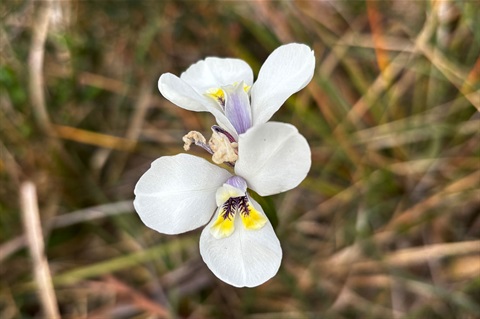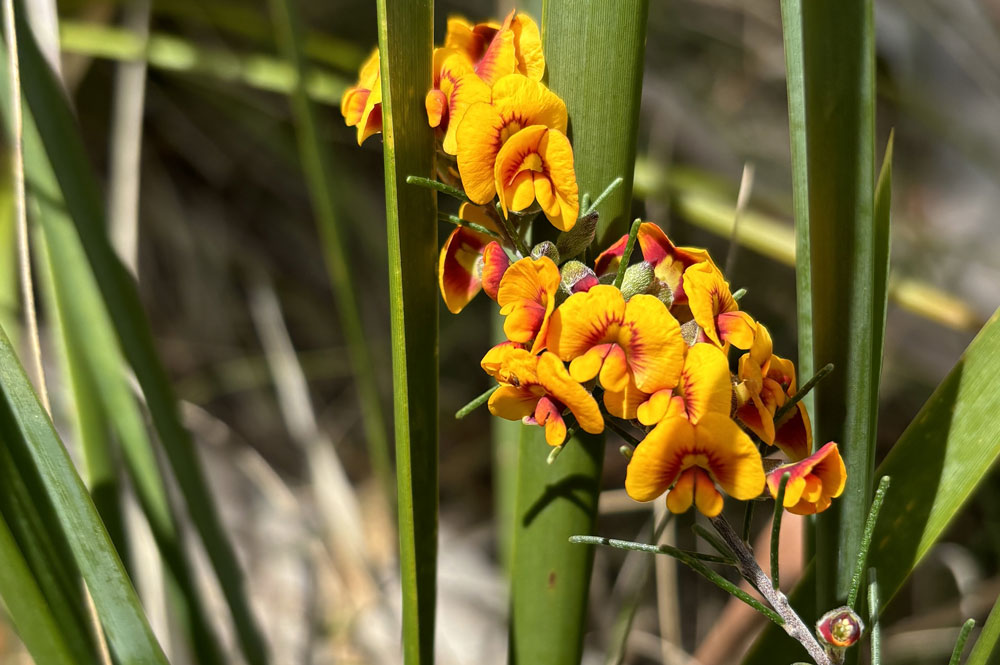
Two tiny pockets of urban bushland at Mt Nelson in Hobart contain treasure troves of biodiversity and are well worth a visit if you love Tasmania's native flowering plants.
Both are just off Brinsmead Road - at 16 and 27 Brinsmead Road – and although they are tiny, the Brinsmead Reserves are packed with spring wildflowers.
Our Mt Nelson Bushcare group recently went looking for wildflowers in one of the reserves, and discovered an amazing array of spring wildflowers.
To get the most out of a wildflower expedition make sure you bring a hand lens or magnifying glass to really see the beauty of these plants up close.
One of our Bushcare volunteers was enraptured when she saw the tiny flowers of the sagg sedge (Lomandra longifolia) for the first time. Saggs are very common, but also very important and very special when they come into flower.
Up close, their sweet-smelling creamy flowers are densely packed among prominent spines – offering up a plump and delicious serving for our native insects!
 A forest candle in full flower, and to the right, spreading pinkbells.
A forest candle in full flower, and to the right, spreading pinkbells.Forest candles at their best
Forest candles (Stackhousia monogyna) were in full flower on our visit, looking their showy and gorgeous best – probably the highlight for most of us on the day because it is short lived and not often seen.
Another fleeting early spring flower is the early Nancy (Wurmbea dioica). This little plant has bright white flowers with a central reddish-purple ring and a prominent blackish-purple ovary – small and lovely.
Less noticeable, but highly worthy of inspection is the innocently named insectivorous pale sundew (Drosera gunniana).
This little plant has globules of sticky glistening fluid that look like dew drops at the ends of long sensitive hairs. Using our hand lenses, we could see tiny insect victims that had become trapped in their sticky hairs. These insects are slowly being turned into fertiliser, liquidised by a caustic digestive enzyme to become a soluble form of nitrogen for the plant.
 The parrotpea's bright yellow and orange flowers make it easy to identify in the bush.
The parrotpea's bright yellow and orange flowers make it easy to identify in the bush.Like peas in a pod
Plants from the pea family were everywhere. The unfortunately named grey parrotpea does not do justice to the bright yellow and orange flowers of Dillwynia cinerascens, which stand out like beacons at this time of year. Their flowers are tightly clustered at the end of spindly, sparsely-leaved stems and bob around colourfully in the understorey.
Spreading pinkbells (Tetratheca procumbens), with their bright purple flowers, were another notable species. Also, blue love creeper (Comesperma volubile) - the twinning climbing plant looked so beautiful tangled among the bushes.
So many of these plants become wonderous under closer inspection. Smart phones are good for this, but nothing beats a hand lens for getting up close and personal with the diverse and changing colours and shapes of Hobart's local bushland.
In another month there will be a change of species, and in summer the native grasses, which also make these forest remnants so special, will be at their best.
The Mt Nelson Bushcare group is looking after this bushland by removing the threat of weeds. They love exploring the native plant-life at this time of year when the bushland smiles and says thank you.
Join Bushcare
It's easy to join the City of Hobart Bushcare program and be part of a growing movement of every day people working together to protect our precious bushlands and wildlife.
Learn more